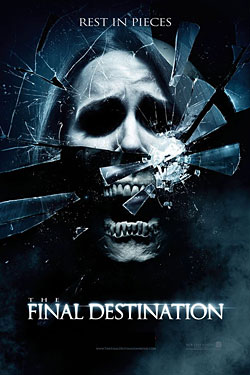
Last year’s The Final Destination was meant to be the last film in the franchise. And yet now, New Line Cinema plans to have a director by the end of the week for a fifth FD movie, which they plan to release in August 2011. Why won’t this franchise die? (Other than creative irony.) Because the last entry, which was near universally panned, more than doubled the worldwide grosses of any previous Final Destination film: It’s still playing around the globe, and is approaching $200 million. Privately, even New Line studio executives admit to being utterly confused by its success: Confides one, “It’s the worst film of the franchise. And that’s not my opinion; that’s everyone’s opinion.” (It got a 27 percent Rotten Tomatoes fresh rating, the lowest of all four movies.)
The normal explanations don’t account for its success: True, the film was released in 3-D, which commands a higher ticket price, but Europe and Asia have far fewer 3-D screens than America, not more. Inflation might account for some of the difference in grosses, but Paul Dergarabedian, the box-office analyst for Hollywood.com, says that the relatively short time between the last film’s release in 2006 and this year’s means that inflation wouldn’t have plumped up its grosses by much, either.
The Final Destination has done better just about everywhere overseas. So far (and it’s still just opening in some countries, like Italy), it’s made $115 million internationally, which is $55.5 million more than the next highest-grossing entry, the first one. Some areas seem particularly crazy about death: Colombia’s grosses quintupled from the third film in the franchise. Australian grosses are three and a half times greater. Dutch, Israeli, and German grosses tripled. And French and Brazilian grosses doubled.
Craig Perry, who has produced all of the Final Destination movies, thinks that what most helped the fourth film was that for the first time, it was not distributed internationally by New Line Cinema, which never had a great international operation even when it was the vaunted mini-studio that released the Lord of the Rings trilogy. And now that it’s just a small genre label within Warner Bros., that giant studio’s muscular distribution arms handled FD4’s overseas release. “That really puts the onus on us for the next one,” says Perry, laughing a little nervously. “If it doesn’t perform, we can’t exactly blame New Line.”
New Line had noticed that the domestic grosses for The Final Destination had been promising, and even though they had no specific calendar to make a fifth, they assigned Eric Heisserer, who had written their Nightmare on Elm Street reboot, currently in theaters, to write a script. But they were surprised to hear Warner’s president, Alan Horn, announce at last spring’s ShoWest that the project was a go, and even more surprised when last month he set an August 26, 2011 release date. Suddenly, they started madly vetting directors.
The fifth film will also be in 3-D, and we hear that the three leading candidates to helm it are all first-time directors, but with considerable expertise in 3-D and special effects: Steve Quale, a second-unit and visual-effects director on Avatar; Bradley Parker, a commercials director and second-unit/visual-effects director on Matt Reeves’s (Cloverfield) forthcoming film Let Me In; and Charles Gibson, the second-unit/visual-effects director on the Pirates of the Carribean movies.
Heisserer turned in a draft of an FD5 script, and now he’s doing rewrites from the set of The Thing (which he also wrote). New Line hopes that the combination of a writer on a hot streak and a fresh director with experience in special effects should bode well for the next film, but that may be just a matter of fate.




